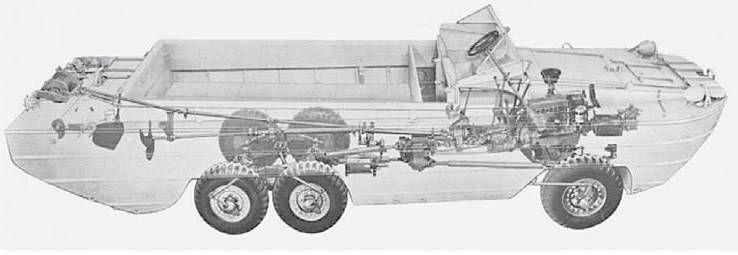DUKW TALES PART ONE


There is something about amphibious vehicles that captures the imagination. There has never been an amphibian as fascinating as the GMC DUKW. Though I have owned, driven, and worked on hundreds of military vehicles, there’s something about a DUKW waddling up through the surf line with its propeller thrashing the water astern while its front wheels claw for a grip on land, that makes it about the ultimate rush for a historic military vehicle (HMV) experience — especially if I’m in the driver’s seat, pulling and pushing what seems to be a hundred levers and controls! As with flying an airplane, landing is usually the busiest part. When “landing” a DUKW one comes to appreciate the saying that any landing you can walk away from was a good one.
Maybe an amphibious vehicle awakens ancient memories of when our remote ancestors first left the ocean, or maybe they’re simply exciting and fun. At such times, there is something about owning a DUKW that makes up for all the hard work of repairing and maintaining one.
ONE-OF-A-KIND
There was never a vehicle quite like the DUKW, and since the last one left the factory in 1945. It seems unlikely there will ever be such a versatile vehicle again.
This is an enigma because DUKWs were probably the most successful and practical amphibious vehicles ever built. In contrast to just about every other later model military amphibian, a DUKW performs equally well in the water or on land.
During WWII, DUKWs served heroically, bringing cargo and troops ashore in the Pacific, Africa, and on the beaches of Normandy, and then evacuating wounded personnel. At Normandy alone, DUKWs landed more than a million tons of cargo during the first 90 days of the invasion at a time when the enemy held all available ports.
Yet, most of the U.S. military’s top brass had been against the DUKW concept. In fact, and even though several prototypes had been built and successfully tested, it wasn’t until a Coast Guard patrol vessel ran aground during a storm off Cape Cod, Mass., that the generals finally woke up and smelled the water. Slashing rain, 60 knot winds, and pounding surf prevented the use of a breeches buoy to rescue the stranded sailors. Fortunately, there was a DUKW, in the area scheduled for a demonstration a few days later. The engineers used it to bring the Guardsmen safely ashore.



In contrast, the DUKW’s closest modern counterpart, the LARC(Lighter, Amphibious, Re-supply, Cargo). While at first glance appearing to be the logical evolution of the species with its sleeker, more boat-like, and corrosion-resistant aluminum hull, the LARC only performs well in the water. Once ashore, it becomes a ten-foot wide lumbering walrus — an amphibious boat able to roll but not very fast and not very far on its inefficient and fuel-sucking hydraulic
You’re reading a preview, subscribe to read more.
Start your free 30 days



